Multi-Phase Structure Control and Interfacial Investigation of TiB2/Hypereutectic Al-Si Alloy
Abstract
:1. Introduction
2. Materials and Methods
2.1. Preparation of 6 wt.% TiB2/Al-20Si Feedstock
2.2. Material Characterisation
3. Results and Discussion
3.1. Temperature Variations in Different Areas of the Wedge Mold
3.2. Microstructure Evolution in Wedge Specimens
4. Conclusions
- (1)
- Different cooling rates had a large effect on the matrix structure. The size of the primary Si phase at the bottom of the specimen was small and uniformly distributed at a larger cooling rate, and the size of the primary Si phase increased significantly as the cooling rate decreased.
- (2)
- TiB2 particles agglomerated in the wedge mold and increased as the cooling rate decreased.
- (3)
- The cooling rate had a significant impact on the engulfment of TiB2 particles in the primary Si phase in the matrix. The greater the cooling rate, the greater the pushing rate of the solidified solid–liquid interface, the faster the growth rate of the primary Si phase, and the more TiB2 particles engulfed. When the cooling rate decreased, the degree of subcooling was not sufficient to engulf smaller TiB2 particles, making only the larger TiB2 particles present.
- (4)
- The interface between TiB2 particles and primary Si was well bonded. There was a semi-coherent lattice interface between TiB2 particles and primary phase Si: , .
- (5)
- TiB2 particles could inhibit the expansion of internal cracks on primary phase Si, and thereby enhance, toughen, and strengthen the material.
Author Contributions
Funding
Data Availability Statement
Conflicts of Interest
References
- Fukui, Y.; Nara, D.; Kumazawa, N. Evaluation of the Deformation Behavior of a Semi-solid Hypereutectic Al-Si Alloy Compressed in a Drop-Forge Viscometer. Metall. Mater. Trans. A 2015, 46, 1908–1916. [Google Scholar] [CrossRef]
- Kapranos, P.; Kirkwood, D.H.; Atkinson, H.V.; Rheinlander, J.T.; Bentzen, J.J.; Toft, P.T.; Debel, C.P.; Laslaz, G.; Maenner, L.; Blais, S. Thixoforming of an automotive part in A390 hypereutectic Al–Si alloy. J. Mater. Process. Technol. 2003, 135, 271–277. [Google Scholar] [CrossRef]
- Cui, C.; Schulz, A.; Schimanski, K.; Zoch, H.W. Spray forming of hypereutectic Al–Si alloys. J. Mater. Process. Technol. 2009, 209, 5220–5228. [Google Scholar] [CrossRef]
- Jw, A.; Zga, B.; Jls, C.; Wxh, C.; Jcl, C.; Smxa, B. On the growth mechanism of the primary silicon particle in a hypereutectic Al-20wt%Si alloy using synchrotron X-ray tomography-ScienceDirect. Mater. Des. 2018, 137, 176–183. [Google Scholar]
- Yu, W.; Zhao, H.; Wang, L.; Guo, Z.; Xiong, S. The influence of T6 treatment on fracture behavior of hypereutectic Al-Si HPDC casting alloy. J. Alloys Compd. 2018, 731, 445–451. [Google Scholar] [CrossRef]
- Wang, A.; Zhang, L.; Xie, J. Effects of cerium and phosphorus on microstructures and properties of hypereutectic Al-21%Si alloy. J. Rare Earths 2013, 31, 522–525. [Google Scholar] [CrossRef]
- Szabracki, P.; Lipiński, T. Mechanical Properties of AISi9Mg Alloy with a Sodium Modifier. Diffus. Defect Data B Solid State Phenom. 2015, 223, 78–86. [Google Scholar]
- Lin, J.; Zhang, J.; Niu, L.; Sun, D.; Shi, Z. Effect of Strontium and T6 Heat Treatment on Structure and Performance of Al-11.6Si-0.5Mg Alloy. Mater. Sci. Forum 2013, 749, 1–6. [Google Scholar] [CrossRef]
- Mazahery, A.; Shabani, M.O. Modification Mechanism and Microstructural Characteristics of Eutectic Si in Casting Al-Si Alloys: A Review on Experimental and Numerical Studies. JOM 2014, 66, 726–738. [Google Scholar] [CrossRef]
- Nogita, K.; Mcdonald, S.D.; Dahle, A.K. Eutectic modification of Al-Si alloys with rare earth metals. Mater. Trans. 2004, 45, 323–326. [Google Scholar] [CrossRef]
- Wu, Y.; Wang, S.; Hui, L.; Liu, X. A new technique to modify hypereutectic Al–24%Si alloys by a Si–P master alloy. J. Alloys Compd. 2009, 477, 139–144. [Google Scholar] [CrossRef]
- Liu, X.; Qiao, J.; Liu, Y.; Li, S.; Bian, X. Modification Performance of the Al-P master alloy for eutectic and hypereutectic Al-Si alloys. Acta Met. Sin. 2004, 40, 471–476. [Google Scholar]
- Dong, X.; Youssef, H.; Zhang, Y.; Wang, S.; Ji, S. High performance Al/TiB_2 composites fabricated by nanoparticle reinforcement and cutting-edge super vacuum assisted die casting process. Composites 2019, 177, 107453. [Google Scholar] [CrossRef]
- Li, J.; Zhao, G.; Wu, S.; Huang, Z.; Lu, S.; Chen, Q.; Li, F. Preparation of hybrid particulates SiCnp and Mg2Si reinforced Al-Cu matrix composites. Mater. Sci. Eng. A 2019, 751, 107–114. [Google Scholar] [CrossRef]
- Majhi, J.; Sahoo, S.K.; Patnaik, S.C.; Sarangi, B.; Sachan, N.K. Effect of alumina on grain refinement of Al-Si hypereutectic alloys. IOP Conf. Ser. Mater. Sci. Eng. 2018, 338, 012048. [Google Scholar] [CrossRef]
- Wu, B.; Reddy, R.G. In-situ formation of SiC-reinforced Al-Si alloy composites using methane gas mixtures. Metall. Mater. Trans. B 2002, 33, 543–550. [Google Scholar] [CrossRef]
- Gan, G.S.; Lei, Z.; Bei, S.Y.; Yi, L.U.; Yang, B. Effect of TiB2 addition on microstructure of spray-formed Si-30Al composite. Trans. Nonferrous Met. Soc. China 2011, 21, 2242–2247. [Google Scholar] [CrossRef]
- Choi, H.; Konishi, H.; Li, X. Al2O3 nanoparticles induced simultaneous refinement and modification of primary and eutectic Si particles in hypereutectic Al–20Si alloy. Mater. Sci. Eng. A 2012, 541, 159–165. [Google Scholar] [CrossRef]
- Ma, G.; Li, L.; Xi, S.; Xiao, Y.; Li, Y.; Yuan, Z.; He, Y.; Zhou, R.; Jiang, Y. Enhanced combination of strength and ductility in the semi-solid rheocast hypereutectic Al Si alloy with the effect of in-situ TiB2 particles. Mater. Charact. 2021, 176, 111143. [Google Scholar] [CrossRef]
- Guo, M.X.; Shen, K.; Wang, M.P. Effect of in situ reaction conditions on the microstructure changes of Cu–TiB 2 alloys by combining in situ reaction and rapid solidification. Mater. Chem. Phys. 2012, 131, 589–599. [Google Scholar] [CrossRef]
- Sun, J.; Zhang, X.B.; Cai, Q.; Zhang, Y.J.; Ma, N.H.; Wang, H.W. Distribution and engulfment behavior of TiB2 particles or clusters in wedge-shaped copper casting ingot. Trans. Nonferrous Met. Soc. China 2015, 25, 54–60. [Google Scholar] [CrossRef]
- Bartels, C.; Raabe, D.; Gottstein, G.; Huber, U. Investigation of the precipitation kinetics in an A16061/TiB2 metal matrix composite. Mater. Sci. Eng. A 1997, 237, 12–23. [Google Scholar] [CrossRef]
- Seo, P.K.; Kang, C.G. The effect of raw material fabrication process on microstructural characteristics in reheating process for semi-solid forming. J. Mater. Process. Technol. 2005, 162, 402–409. [Google Scholar] [CrossRef]
- Agaliotis, E.M.; Schvezov, C.E.; Rosenberger, M.R.; Ares, A.E. A numerical model study of the effect of interface shape on particle pushing. J. Cryst. Growth 2012, 354, 49–56. [Google Scholar] [CrossRef]
- Li, P.; Li, Y.; Wu, Y.; Ma, G.; Liu, X. Distribution of TiB2 particles and its effect on the mechanical properties of A390 alloy. Mater. Sci. Eng. A 2012, 546, 146–152. [Google Scholar] [CrossRef]
- Stefanescu, D.M.; Dhindaw, B.K.; Kacar, S.A.; Moitra, A. Behavior of ceramic particles at the solid- liquid metal interface in metal matrix composites. Metall. Trans. A 1988, 19, 2847–2855. [Google Scholar] [CrossRef]
- KöRber, C.; Rau, G.; Cosman, M.D.; Cravalho, E.G. Interaction of particles and a moving ice-liquid interface. J. Cryst. Growth 1985, 72, 649–662. [Google Scholar] [CrossRef]
- Agaliotis, E.; Rosenberger, M.R.; Schvezov, C.E.; Ares, A.E. Numerical calculation of the drag force applied to particle pushing. J. Cryst. Growth 2008, 310, 1366–1370. [Google Scholar] [CrossRef]
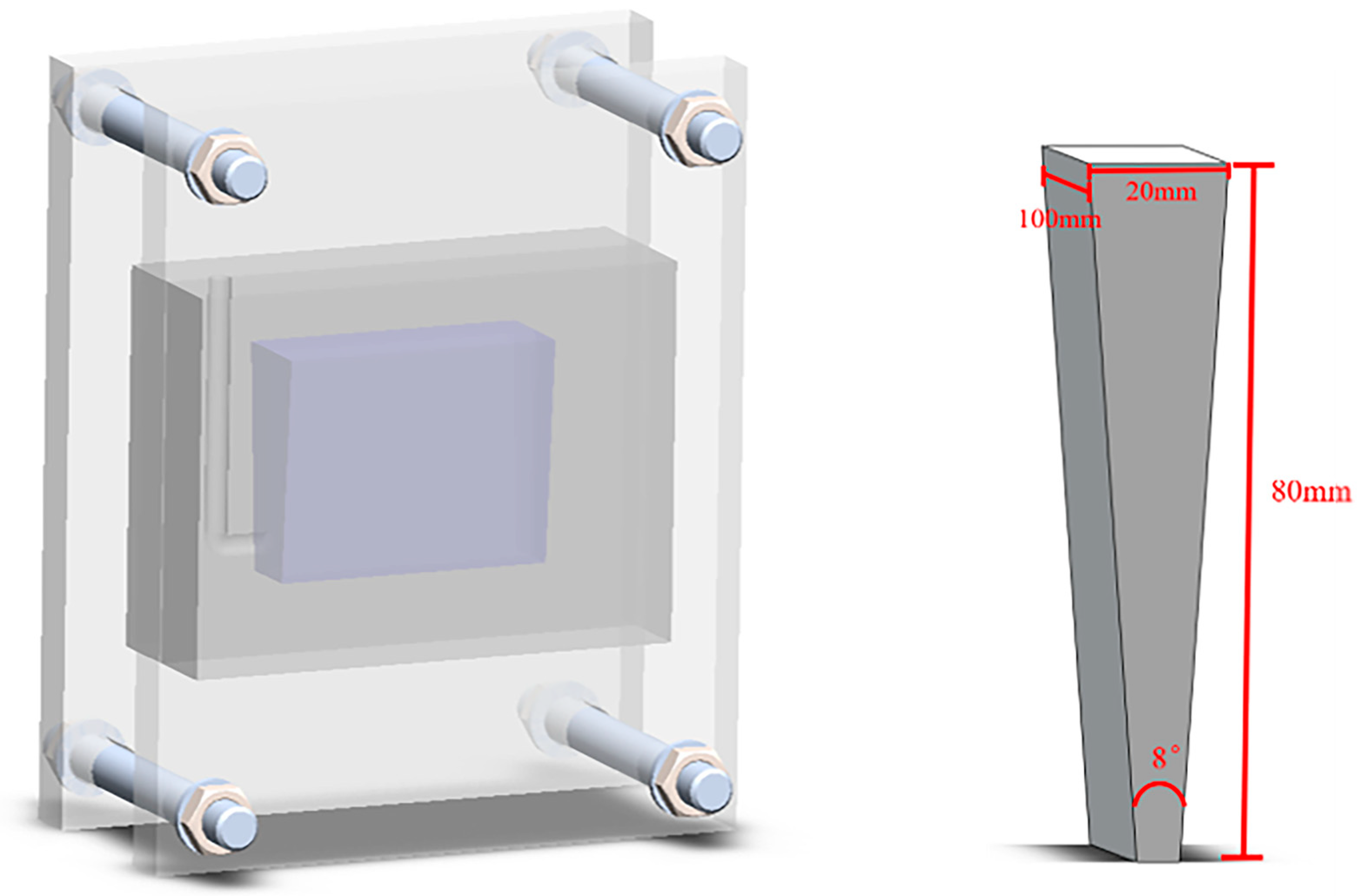

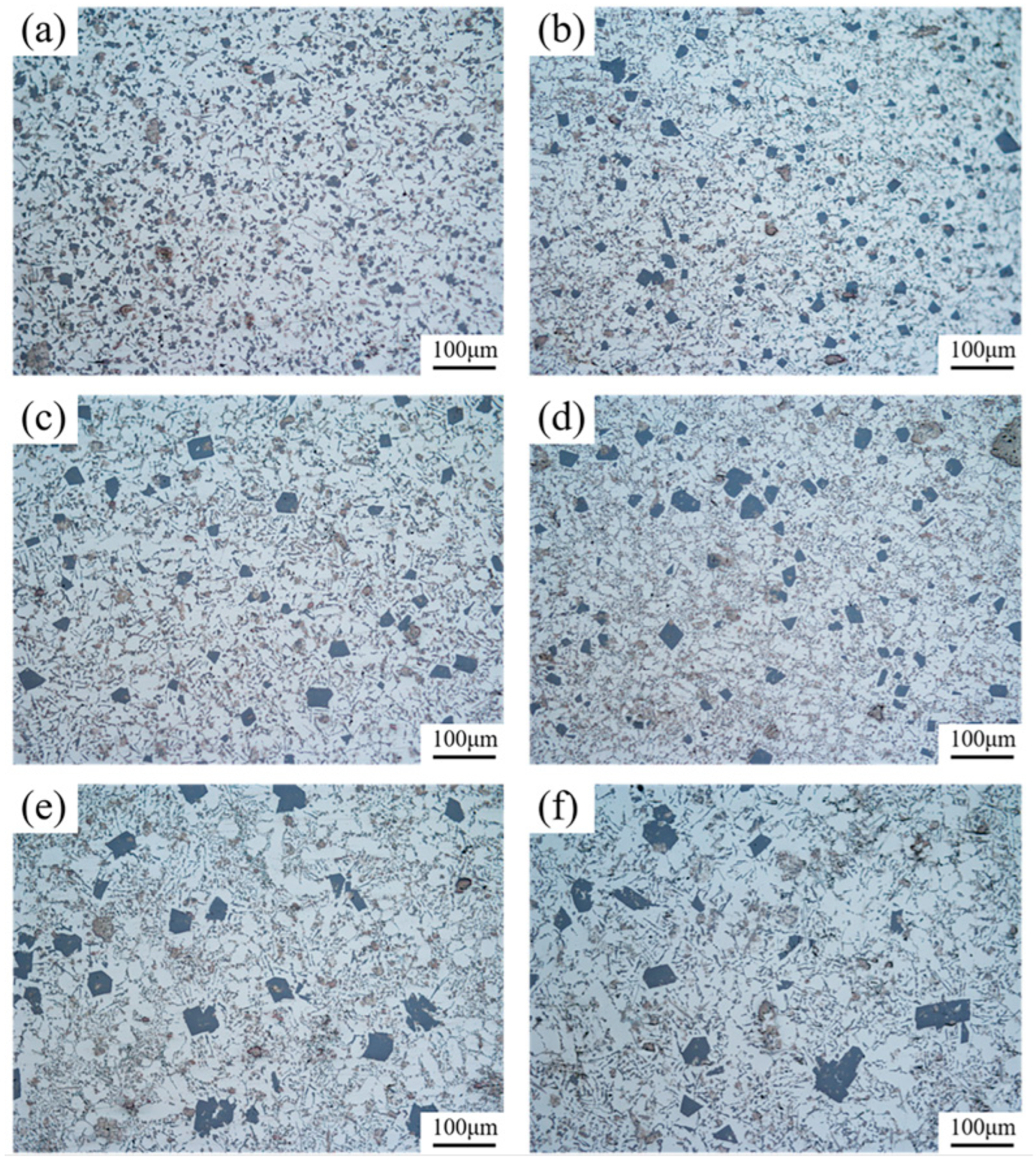
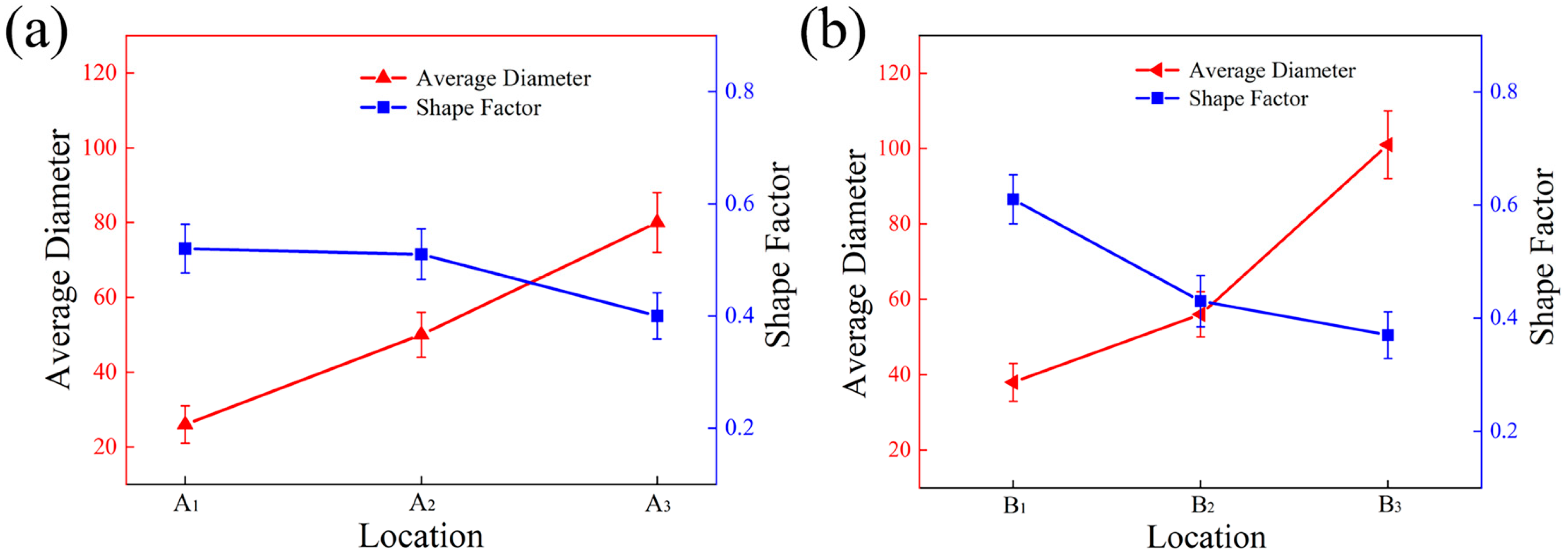

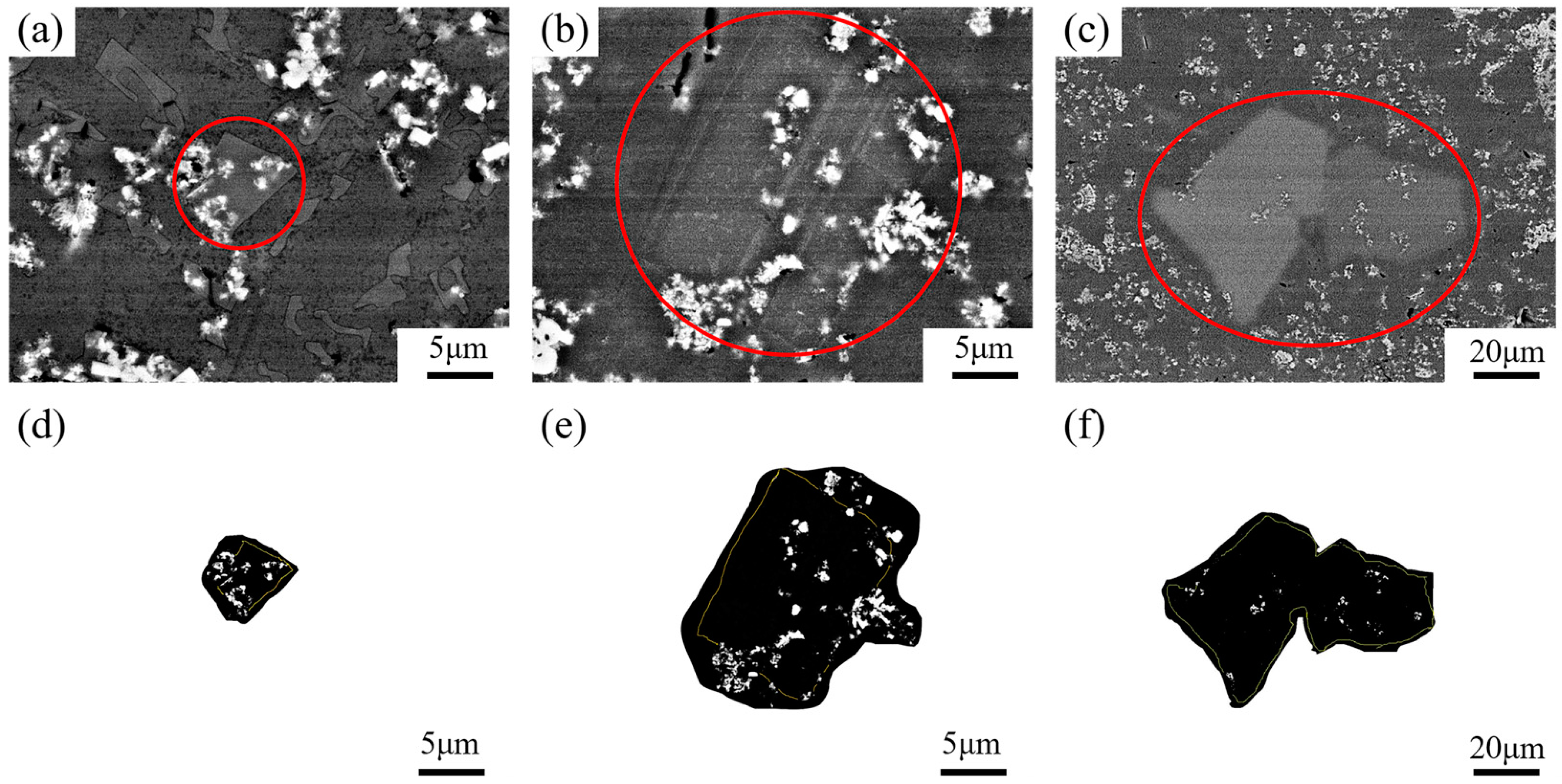
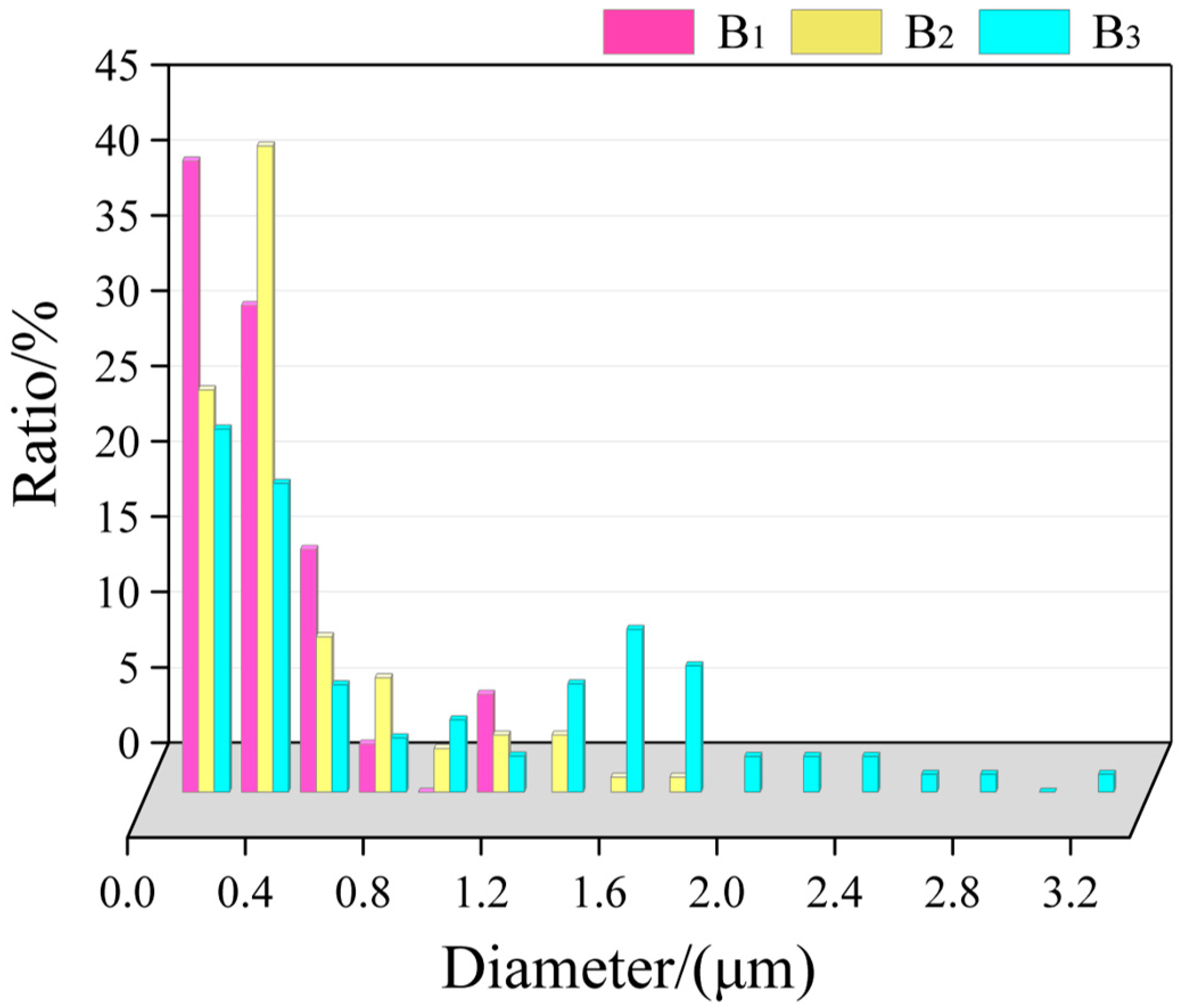

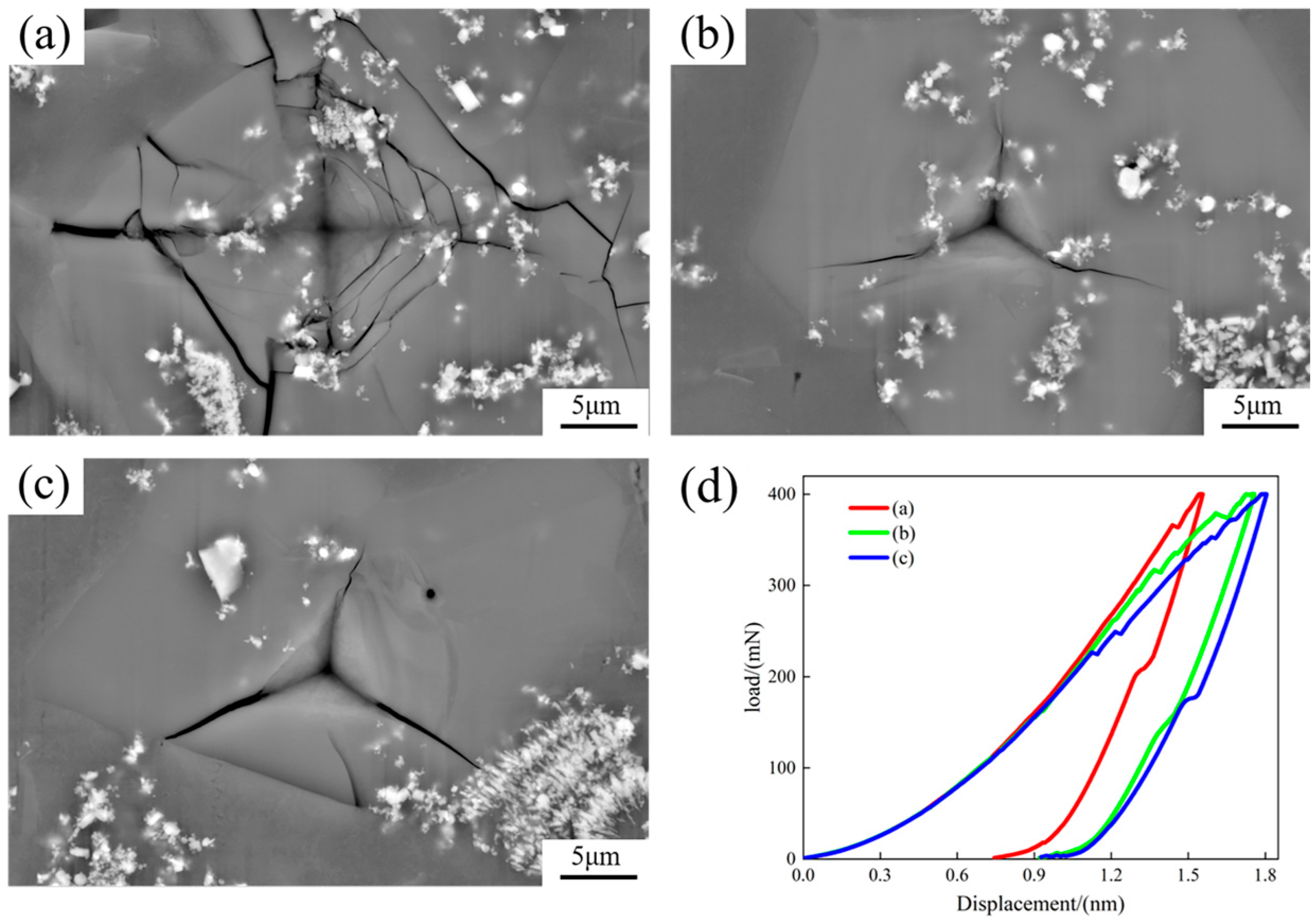

| Ingredients | Si | Ti | B | Fe | Mg | Mn | Al |
| Content | 19.79 | 3.66 | 2.18 | 0.10 | 0.12 | 0.11 | Bal. |
Disclaimer/Publisher’s Note: The statements, opinions and data contained in all publications are solely those of the individual author(s) and contributor(s) and not of MDPI and/or the editor(s). MDPI and/or the editor(s) disclaim responsibility for any injury to people or property resulting from any ideas, methods, instructions or products referred to in the content. |
© 2023 by the authors. Licensee MDPI, Basel, Switzerland. This article is an open access article distributed under the terms and conditions of the Creative Commons Attribution (CC BY) license (https://creativecommons.org/licenses/by/4.0/).
Share and Cite
Li, C.; Zhang, X.; Guo, Z.; Li, L.; Shan, Q.; Li, Z. Multi-Phase Structure Control and Interfacial Investigation of TiB2/Hypereutectic Al-Si Alloy. Metals 2023, 13, 933. https://doi.org/10.3390/met13050933
Li C, Zhang X, Guo Z, Li L, Shan Q, Li Z. Multi-Phase Structure Control and Interfacial Investigation of TiB2/Hypereutectic Al-Si Alloy. Metals. 2023; 13(5):933. https://doi.org/10.3390/met13050933
Chicago/Turabian StyleLi, Chuanyong, Xingguo Zhang, Zhengwei Guo, Lu Li, Quan Shan, and Zulai Li. 2023. "Multi-Phase Structure Control and Interfacial Investigation of TiB2/Hypereutectic Al-Si Alloy" Metals 13, no. 5: 933. https://doi.org/10.3390/met13050933




